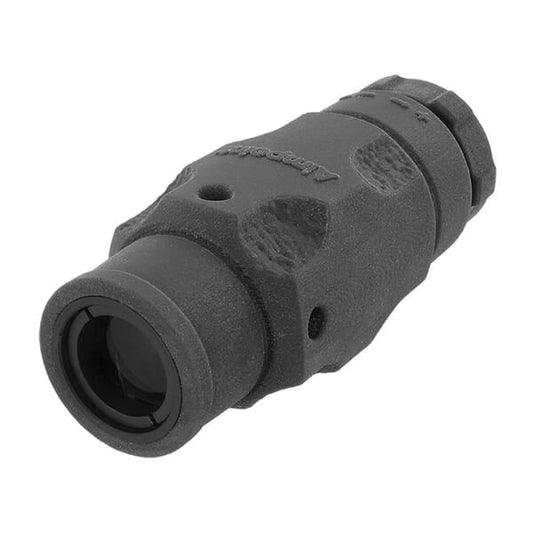

Aimpoint 3X Mag-1 Magnifier enhances the performance of Aimpoint red dot sights by providing 3x optical magnification. This device is designed for precise target acquisition over longer distances, making it suitable for military, law enforcement, competitive shooting, and hunting applications. With a clear 2 MOA dot and intuitive windage and elevation adjustments, users can quickly center the dot for accurate aiming.
Built for durability, the Aimpoint 3X Mag-1 is fully shockproof and submersible up to 80 feet, ensuring reliability in harsh conditions. It operates effectively in a wide temperature range from -49°F to +160°F. The ergonomic design, featuring a protective rubber cover, allows for comfortable handheld use, while the variable dioptric adjustment ensures compatibility with individual eyesight needs.
Key Features:
- OPTICAL PERFORMANCE: 3x magnification and 7-degree field of view for enhanced target identification and engagement at extended ranges.
- COMPATIBILITY: Optimized for use with Aimpoint red dot sights, including Micro T-2/H-2, Patrol Rifle Optic, CompM4, and CompM5 series.
- DURABILITY: Fully shockproof and submersible up to 80 feet, with an operating temperature range from -49°F to +160°F.
- VERSATILITY: Can be used as a standalone handheld 3x monocular or paired with Aimpoint sights for added functionality.
- ERGONOMIC DESIGN: Protective rubber cover provides a secure grip for easy handheld use.
- ADJUSTABILITY: Variable (-3 to +3) dioptric setting allows for individual eye adaptation for optimal clarity.
- EASE OF USE: No re-zeroing needed when switching between magnified and non-magnified aiming, simplifying the user experience.
- MOUNTING OPTIONS: Compatible with Aimpoint TwistMount and FlipMount (sold separately) for flexible installation options.
Technical Specifications
| Specification | Detail |
|---|---|
| Magnification | 3x |
| Field of View | 7 degrees |
| Eye Relief | 2.8 in (70 mm) |
| Dioptric Adjustment | -3 to +3 |
| Submersible Depth | 80 feet (25 meters) |
| Temperature Range | -49°F to +160°F (-45°C to +71°C) |
| Weight | 8.1 oz (230 g) |
| Dimensions | 4 9/16" x 1 13/16" x 1 11/16" |
| Tube Diameter | 30 mm |
| Length | 113 mm |
| Width | 56 mm |
| Height | 69 mm |
| Color | Black |
| Finish | Matte |
| Material | Aluminum |
What's in the Box?
- Aimpoint 3X Mag-1 Magnifier
- Protective rubber cover
- Screws and Allen key
Customer Reviews
“This magnifier makes long-range shooting much easier. The clarity is impressive.”
“I use it with my Aimpoint sight, and it has improved my accuracy significantly.”
“Built tough and performs well in all weather. Highly recommend for serious shooters!”
FAQ
Many potential buyers ask about the performance of the Aimpoint 3X Mag-1 in low-light situations. Its robust design and clear optics allow for effective target acquisition even in less-than-ideal lighting conditions, making it a reliable choice for evening hunts or tactical operations.
Maintenance concerns are common, especially regarding the durability of the device. The magnifier is shockproof and submersible, meaning it can withstand harsh environments. Regular cleaning of the lenses and using a protective cover will ensure longevity and optimal performance.
When comparing the 3X Mag-1 with other magnifiers, users often inquire about compatibility with various optics. This magnifier is designed specifically for Aimpoint sights, ensuring seamless integration and performance that aligns with other Aimpoint products, providing a significant advantage over generic alternatives.
Similar Models
Looking for additional optical solutions? Explore other Aimpoint products, including the Aimpoint Micro T-2 for compact versatility and the Aimpoint CompM5 for enhanced tactical performance. Our complete collection offers various options to suit every shooter's needs.
You May Also Like
Here’s some of our most similar products people are buying. Click to discover trending style.






